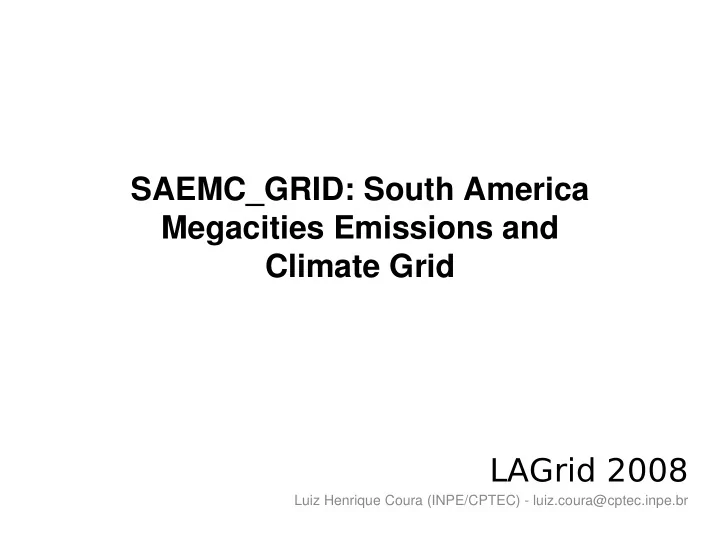

SAEMC_GRID: South America Megacities Emissions and Climate Grid LAGrid 2008 Luiz Henrique Coura (INPE/CPTEC) - luiz.coura@cptec.inpe.br
Agenda • Introduction • SAEMC Project • Tools CATT-BRAMS and CCATT-BRAMS – GBRAMS Project – • Objective • SAEMC Grid Portal • Network support • SAEMC Computational Grid • Future plans
Introduction Megacities concentrate anthropogenic sources of atmospheric pollutants with consequences on local air quality and on regional and global atmospheric chemistry. Rio de Janeiro - Brazil São Paulo - Brazil Santiago - Chile
SAEMC project South American Emissions, Megacities and Climate project is a joint effort between several South American institutions funded by the Inter-American Institute for Global Change Research (IAI). Goals • To provide accurate regional emissions and climate change scenarios for South America, with emphasis on the impacts of and on megacities. • To establish the basis for operational chemical weather forecast for South American megacities. • To strengthen and expand an active research and capacity building network in the Americas functional to Earth System Modeling.
SAEMC project Expected Results • The proposed work will provide regional scale past, present and future climate change scenarios, with a unique emphasis on the evolution of air quality in South American megacities, where more than 75% of the population of the continent lives. Such high resolution scenarios are not currently available for this area of the world. • Comparable estimate and evaluation methodologies, as well as, reconciled local, regional and global scale emission inventories will be produced for South America, a region up to date poorly constrained in this respect despite its potential vulnerability to global change and its effects, particularly in megacities.
SAEMC project Expected Results • A well established and enhanced research network, particularly in terms of educated human resources, able to better contribute to and lead global change research in the Americas within the framework of Earth System Modeling. • Unique and new databases functional to various other relevant research issues and assessments, among which human health, ecology, water and energy resources, economics and city planning.
SAEMC project Methodology and approach • Mobile and Stationary emissions scenarios estimate and evaluation • Dynamical down-scaling of climate change scenarios • Pilot implementation of chemical weather forecast network and tools for South American megacities (SAEMC_GRID) • Prospective characterization of aerosols in and downwind from South American megacities
Tools Numerical Models (environmental model ) Grid Computing
Where will it stop?
CATT-BRAMS C oupled A erosol and T racer T ransport model to the B razilian developments on the R egional A tmospheric M odeling S ystem is an on-line transport model fully consistent with the simulated atmospheric dynamics. The atmospheric transport of emissions is studied through a numerical simulation of the air mass motions using it. Some sub-grid process involved at gases/aerosols transport and simulated by CATT-BRAMS model
CATT-BRAMS It’s currently the operational air quality model at INPE/CPTEC http://meioambiente.cptec.inpe.br
CCATT-BRAMS C oupled C hemistry A erosol and T racer T ransport model to the B razilian developments on the R egional A tmospheric M odeling S ystem.
GBRAMS Project Goals •Test viability of grids for meteorological numerical models • Generate ten years monthly of meteorological model BRAMS climatology, based in ensemble means (three members) • Strategy applied for three regions of Brazil: North, Northeast and South/Southeast • Three grid middleware compared (GLOBUS, OAR/CIGRI and OURGRID)
GBRAMS Project Three node grids: 16 processors Xeon 3.0 GHz: • • INPE/CPTEC (Cachoeira Paulista) 12 processors Opteron 2.6 GHz; • • INPE/LAC (São José dos Campos) • II/UFRGS (Porto Alegre)
GBRAMS Project Regional climatology was obtained using an average over the ensemble, which is a set of BRAMS long range integration for each one of the 3 areas : North, Northeast e South/Southeast. The 3 areas and 3 members simulation represents 9 independent integrations . Therefore, these integrations can be executed in the same time, if there are computing resources avaliable. In order to the execution becomes more flexible, each N years integration, one area and one member was divided by year, splitted in small executions (jobs) that, although they depend on each other, they can be executed in different computers as become avaliable.
Data processing for each megacity can be considered independent. Well suitable for running in geographically distributed clusters, using Grid technology.
Objective The main idea of this proposal is to describe a project for a computational grid that will be accessed through a grid portal where the CCATT-BRAMS will be used as chemical weather forecast for selected megacities of South America.
SAEMC Grid Portal • Job Submission • Job Management • Data Presentation CCATT-BRAMS Itanium2 and one Xeon-class based, located at CMM (Santiago - Chile), and one Linux clusters, a Xeon-class one, at INPE/CPTEC (Cachoeira Paulista - Brazil) CCATT-BRAMS
SAEMC Grid Portal: Job Submission
SAEMC Grid Portal: Job Management
SAEMC Grid Portal: Data Presentation
Network Support - RNP RNP National Network for Education and Research INPE/CPTEC 155 Mbps high availability connection
Network Support - CLARA CLARA Cooperación Latino Americana de Redes Avanzadas
Network Support - REUNA REUNA Red Universitaria Nacional
SAEMC Computational Grid Globus Toolkit will be used as middleware to connect Linux clusters: • User identification (GSI – Grid Security Infrastructure) • Control and submission of jobs (GRAM – Globus Resource Allocation Manager) • Safe mechanism for data transfer (GridFtp) • Workflow management • Metascheduler (GridWay) Itanium2 and one Xeon-class based, located at CMM (Santiago - Chile), and one Linux clusters, a Xeon-class one, at INPE/CPTEC (Cachoeira Paulista - Brazil)
Future plans • Connect CNEA (Argentina) and UPB (Colombia) to computational grid
Thank you! Questions?
Recommend
More recommend